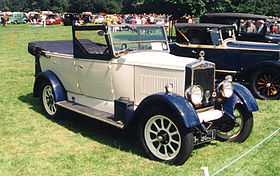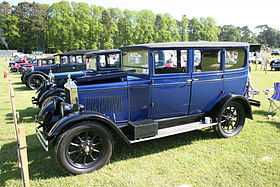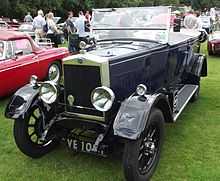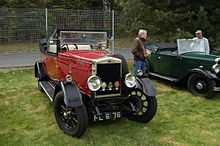Morris Oxford flatnose
| Morris Oxford | |
|---|---|
 Oxford flatnose tourer 1927 | |
| Overview | |
| Manufacturer |
Morris Motors British Motor Corporation British Leyland |
| Production |
1913-1914 1919–1935 1948-1971 |
| Body and chassis | |
| Class | Small car |
Morris Oxford is a series of motor car models produced by Morris Motors of the United Kingdom, from the 1913 bullnose Oxford to the Farina Oxfords V and VI.
Named by W R Morris after the city of dreaming spires, the university town in which he grew up, the manufacture of Morris's Oxford cars would turn Oxford into an industrial city.
From 1913 to mid-1935 Oxford cars grew in size and quantity. In 1923 they with the Cowley cars were 28.1 per cent of British private car production. In 1925 Morris sold near double the number and they represented 41 per cent of British production. The model name was recycled in 1948 and lasted almost another 23 years through to 1971 but in this time the market sector and engine-size remained nearly constant between 1476 cc and 1622 cc.
Aside from the Oxford Sixes and the Oxford Empire models all Oxfords since 1918 have been 12 or 14 HP cars of about 1500 to 1800 cc..
Oxford flatnose 1926–30
| Oxford flatnose | |
|---|---|
 Oxford 4-door saloon 1927 | |
| Overview | |
| Production |
1926–30 (4-cylinder) 32,282 made.[1] |
| Body and chassis | |
| Body style |
4-door tourer
|
| Powertrain | |
| Engine | 1802 cc side-valve Straight-4 |
| Dimensions | |
| Wheelbase | 106.5 in (2,710 mm)[2] |
| Chronology | |
| Predecessor | Morris Oxford bullnose |
| Successor | Morris Oxford Six |
The distinctive bullnose radiator was dropped in 1926 in an updated version of the car. The engines remained the same but a new range of bodies was offered including all-steel saloons.[3]
The frame was changed to allow half-elliptic springs to be fitted in place of the old three-quarter elliptic springs. The back end of the frame was given a deeper channel section, it now sweeps up over the rear axle. The frame also receives bracing from the running board brackets and cross hangers.[2]
The radiator cooling surface has been increased sixty per cent and the whole assembly given the flat-fronted shape which would lead to this car's popular name.[2]
A new all-steel dash or bulkhead now creates a firm location for bodywork and a solid support for the petrol tank. As part of that redesign a new instrument panel is provided with neatly grouped meters and glove boxes either side. The hand controls on the steering column have been upgraded. There is now a dash-operated ventilator.[2]
Equipment includes:[2]
- dash-operated ventilator
- adjustable shock absorbers
- luggage grid
- dipping headlamps
- non-glare instrument illumination.
 4-door tourer registered October 1927 |
 2-seater drophead coupé registered Jun 1927 |
References
Footnotes
Bibliography
- Davis, Pedr (1986). The Macquarie Dictionary of Motoring.
| Wikimedia Commons has media related to Morris Oxford Flatnose. |